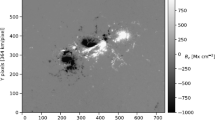Abstract
Numerical reconstruction/extrapolation of the coronal nonlinear force-free magnetic field (NLFFF) usually takes the photospheric vector magnetogram as input at the bottom boundary. The magnetic field observed at the photosphere, however, contains a force that is in conflict with the fundamental assumption of the force-free model. It also contains measurement noise, which hinders the practical computation. Wiegelmann, Inhester, and Sakurai (Solar Phys. 233, 215, 2006) have proposed to preprocess the raw magnetogram to remove the force and noise to provide better input for NLFFF modeling. In this paper we develop a new code of magnetogram preprocessing that is consistent with our extrapolation method CESE–MHD–NLFFF (Jiang, Feng, and Xiang in Astrophys. J. 755, 62, 2012; Jiang and Feng in Astrophys. J. 749, 135, 2012a). Based on the magnetic-splitting rule that a magnetic field can be split into a potential-field part and a non-potential part, we split the magnetogram and dealt with the two parts separately. The preprocessing of the magnetogram’s potential part is based on a numerical potential-field model, and the non-potential part is preprocessed using the similar optimization method of Wiegelmann, Inhester, and Sakurai (2006). The code was applied to the SDO/HMI data, and results show that the method can remove the force and noise efficiently and improve the extrapolation quality.







Similar content being viewed by others
Notes
There are also some NLFFF models that use only the line-of-sight component of the photospheric field, along with constraints from other observed information such as the EUV loops, filament channels, and X-ray sigmoid structure (e.g., Bobra, van Ballegooijen, and DeLuca 2008; Su et al. 2009; Aschwanden et al. 2012).
The necessary conditions mean that even fulfilling these conditions, the magnetogram may still contain force; but magnetograms that fulfill these conditions are certainly better input for the NLFFF model than those that do not.
References
Aly, J.J.: 1989, Solar Phys. 120, 19.
Amari, T., Boulmezaoud, T.Z., Aly, J.J.: 2006, Astron. Astrophys. 446, 691.
Amari, T., Aly, J.J., Luciani, J.F., Boulmezaoud, T.Z., Mikic, Z.: 1997, Solar Phys. 174, 129.
Aschwanden, M.J., Wuelser, J.P., Nitta, N.V., Lemen, J.R., DeRosa, M.L., Malanushenko, A.: 2012, Astrophys. J. 756, 124.
Bobra, M.G., van Ballegooijen, A.A., DeLuca, E.E.: 2008, Astrophys. J. 672, 1209.
Borrero, J., Tomczyk, S., Kubo, M., Socas-Navarro, H., Schou, J., Couvidat, S., Bogart, R.: 2011, Solar Phys. 273, 267.
DeRosa, M.L., Schrijver, C.J., Barnes, G., Leka, K.D., Lites, B.W., Aschwanden, M.J. et al.: 2009, Astrophys. J. 696, 1780.
Fuhrmann, M., Seehafer, N., Valori, G.: 2007, Astron. Astrophys. 476, 349.
Fuhrmann, M., Seehafer, N., Valori, G., Wiegelmann, T.: 2011, Astron. Astrophys. 526, A70.
Gary, G.A.: 2001, Solar Phys. 203, 71.
Inoue, S., Kusano, K., Magara, T., Shiota, D., Yamamoto, T.T.: 2011, Astrophys. J. 738, 161.
Jiang, C., Feng, X., Xiang, C.: 2012, Astrophys. J. 755, 62.
Jiang, C.W., Feng, X.S.: 2012, Astrophys. J. 749, 135.
Jiang, C.W., Feng, X.S.: 2012, Solar Phys. 281, 621.
Jiang, C.W., Feng, X.S.: 2013, Astrophys. J. 769, 144.
Leka, K., Barnes, G., Crouch, A., Metcalf, T., Gary, G., Jing, J., Liu, Y.: 2009, Solar Phys. 260, 83.
Liu, S., Su, J.T., Zhang, H.Q., Deng, Y.Y., Gao, Y., Yang, X., Mao, X.J.: 2013, Publ. Astron. Soc. Aust. 30, e005. doi: 10.1017/pasa.2012.005 , ADS: 2013PASA...30....5L .
McClymont, A.N., Jiao, L., Mikic, Z.: 1997, Solar Phys. 174, 191.
Metcalf, T.R., Jiao, L., McClymont, A.N., Canfield, R.C., Uitenbroek, H.: 1995, Astrophys. J. 439, 474.
Metcalf, T.R., DeRosa, M.L., Schrijver, C.J., Barnes, G., van Ballegooijen, A.A., Wiegelmann, T., Wheatland, M.S., Valori, G., McTtiernan, J.M.: 2008, Solar Phys. 247, 269.
Press, W.H., Teukolsky, S.A., Vetterling, W.T., Flannery, B.P.: 1992, Numerical Recipes in FORTRAN. The Art of Scientific Computing, Cambridge University Press, Cambridge, 414.
Sakurai, T.: 1989, Space Sci. Rev. 51, 11.
Su, Y., van Ballegooijen, A., Lites, B.W., Deluca, E.E., Golub, L., Grigis, P.C., Huang, G., Ji, H.: 2009, Astrophys. J. 691, 105.
Tadesse, T.: 2011, Nonlinear force-free reconstruction of the coronal magnetic field with advanced numerical methods, Ph.D. thesis, Max Planck Institute for Solar System Research.
Turmon, M., Jones, H.P., Malanushenko, O.V., Pap, J.M.: 2010, Solar Phys. 262, 277.
Valori, G., Kliem, B., Fuhrmann, M.: 2007, Solar Phys. 245, 263.
Wheatland, M.S., Sturrock, P.A., Roumeliotis, G.: 2000, Astrophys. J. 540, 1150.
Wiegelmann, T.: 2004, Solar Phys. 219, 87.
Wiegelmann, T.: 2008, J. Geophys. Res. 113, 3.
Wiegelmann, T., Inhester, B., Sakurai, T.: 2006, Solar Phys. 233, 215.
Wiegelmann, T., Neukirch, T.: 2006, Astron. Astrophys. 457, 1053.
Yamamoto, T.T., Kusano, K.: 2012, Astrophys. J. 752, 126.
Acknowledgements
This work is jointly supported by the 973 program under grant 2012CB825601, the Chinese Academy of Sciences (KZZD-EW-01-4), the National Natural Science Foundation of China (41204126, 41274192, 41031066, and 41074122), and the Specialized Research Fund for State Key Laboratories. Data are courtesy of NASA/SDO and the HMI science teams. The authors thank the anonymous referee for invaluable comments.
Author information
Authors and Affiliations
Corresponding author
Rights and permissions
About this article
Cite this article
Jiang, C., Feng, X. Preprocessing the Photospheric Vector Magnetograms for an NLFFF Extrapolation Using a Potential-Field Model and an Optimization Method. Sol Phys 289, 63–77 (2014). https://doi.org/10.1007/s11207-013-0346-0
Received:
Accepted:
Published:
Issue Date:
DOI: https://doi.org/10.1007/s11207-013-0346-0




